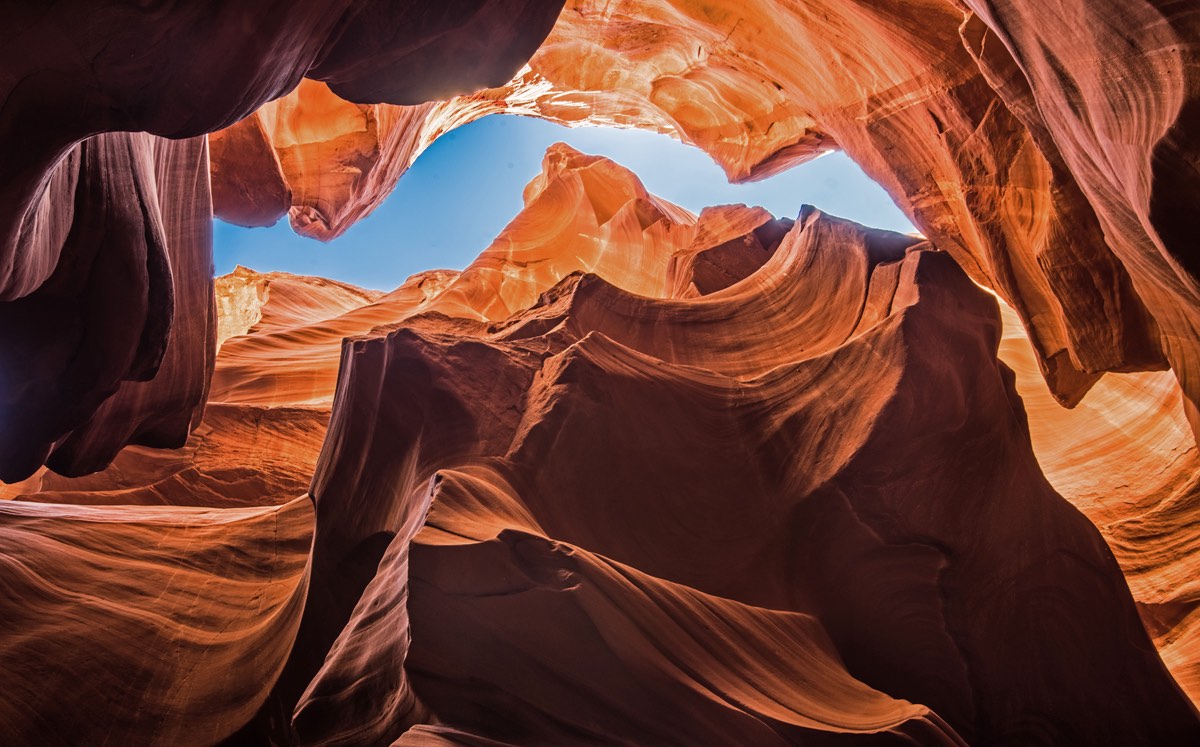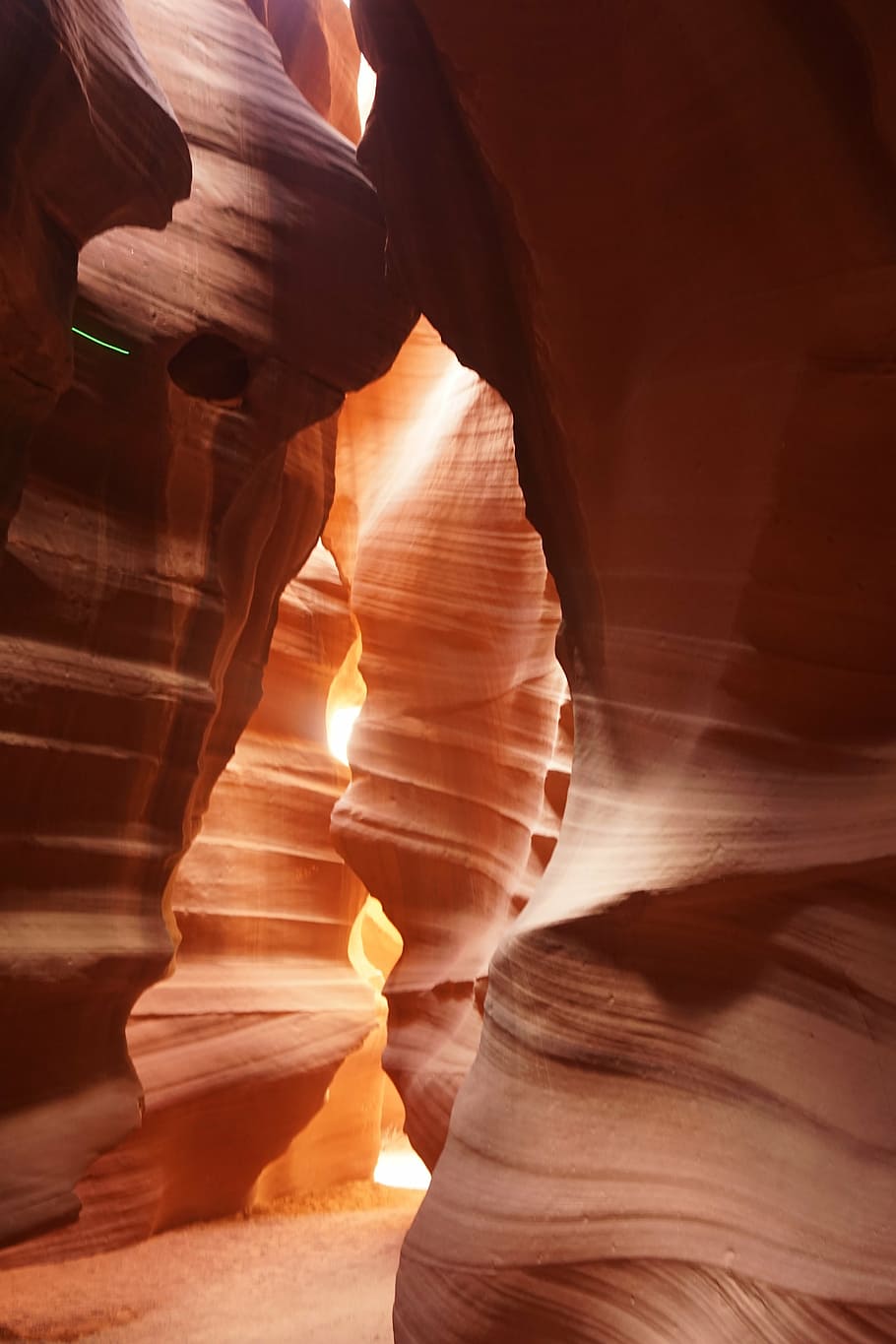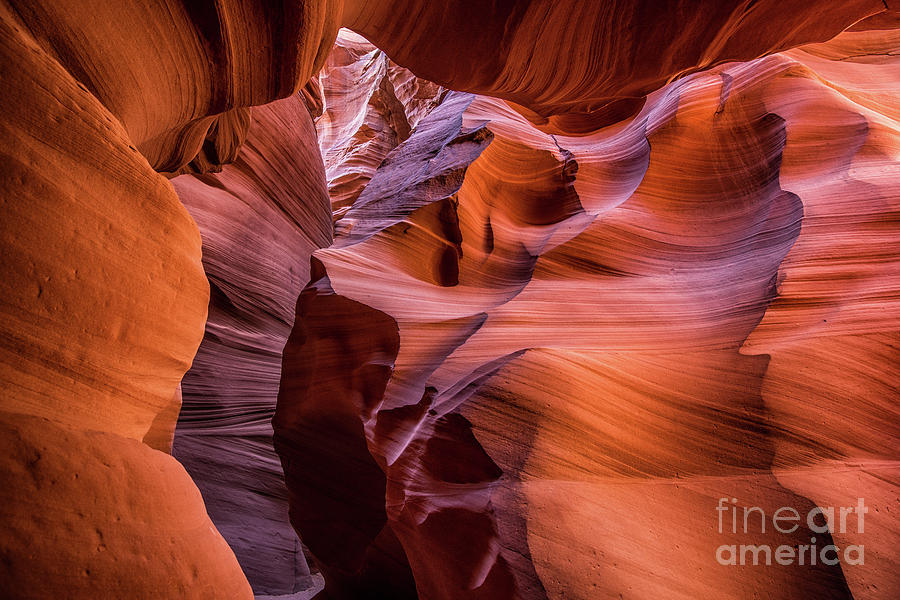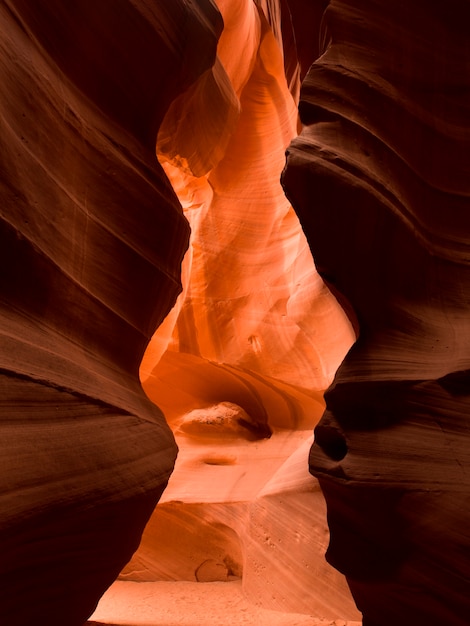Antelope Canyon Slots Arizona
| Antelope Canyon | |
|---|---|
| Tsé bighánílíní dóó Hazdistazí(in Navajo) | |
Navajo Nation, Coconino County, near Page, Arizona | |
| Floor elevation | 3,704 ft (1,129 m)[1] |
| Length | Upper Antelope Canyon: about 660 feet (200 m)[2] Lower Antelope Canyon: about 1,335 feet (407 m)[2] |
| Depth | about 120 feet (37 m)[3] |
| Geology | |
| Type | Sandstoneslot canyon[3] |
| Geography | |
| Population centers | Page |
| Coordinates | 36°57′10″N111°26′29″W / 36.9527664°N 111.4412683°WCoordinates: 36°57′10″N111°26′29″W / 36.9527664°N 111.4412683°W[1] |
| Topo map | USGS Page |
Antelope Canyon is a slot canyon in the American Southwest, on Navajo land east of Page, Arizona. It includes two separate, scenic slot canyon sections, referred to as Upper Antelope Canyon (or The Crack), and Lower Antelope Canyon (or The Corkscrew).[2]

Come with me on a walk through Antelope Slot Canyon located near Page, Arizona.The beauty of the canyon is accentuated by the changing light, as the light changes, as the sun moves, the canyon walls change and there are new visions. Antelope Canyon is located on Navajo Indian Tribal Lands, therefore, it is necessary to have a tour guide, licensed by the tribe, escort you into Antelope Canyon and its alternate slot canyons. You cannot go on your own. Should I book an Antelope Canyon tour in advance, or can I simply book it when I get there? Antelope Canyon, located near Page, Arizona is home to one of nature's most wondrous creations – the slot canyon. Carved from the red sandstone for millennia by seasonal flood rains and wind, the canyons are narrow passageways that lead several hundred feet away from the mouth. Over the years, Lower Antelope Canyon has become a favorite gathering place for photographers, tourists, and visitors from around the world. The views in Lower Antelope Canyon change constantly as the sun moves across the sky, filtering lights softly across the stone walls.
The Navajo name for Upper Antelope Canyon is Tsé bighánílíní, which means 'the place where water runs through rocks'. Lower Antelope Canyon is Hazdistazí (called 'Hasdestwazi' by the Navajo Parks and Recreation Department), or 'spiral rock arches'. Both are in the LeChee Chapter of the Navajo Nation.[4] They are accessible by guided tour only.
Geology[edit]

Antelope Canyon was formed by the erosion of Navajo Sandstone[2] due to flash flooding and other sub-aerial processes. Rainwater, especially during monsoon season, runs into the extensive basin above the slot canyon sections, picking up speed and sand as it rushes into the narrow passageways. Over time the passageways eroded away, deepening the corridors and smoothing hard edges to form characteristic 'flowing' shapes.[3]
Tourism and photography[edit]

Antelope Canyon Slots Arizona State

Antelope Canyon is a popular location for photographers and sightseers, and a source of tourism business for the Navajo Nation. It has been accessible by tour only since 1997, when the Navajo Tribe made it a Navajo Tribal Park. Besides the Upper and Lower areas, there are other slots in the canyon that can be visited, such as the Canyon X which is also part of the same drainage as Antelope Canyon. All visits are through one of several licensed tour operators. It is not possible to visit the Canyon independently.[5]
Photography within the canyons is difficult due to the wide range exposure range (often 10 EV or more) made by light reflecting off the canyon walls.[6] For several years, there was a specialized 'photographer tour' of the Upper Antelope Canyon, where participants needed to have a tripod and camera. These were discontinued at the end of 2019 to improve the experience for the larger number of people on the general tours.
Upper Antelope Canyon[edit]
Upper Antelope Canyon is called Tsé bighánílíní, 'the place where water runs through rocks' by the Navajo. It is the most frequently visited by tourists because its entrance and entire length are at ground level, requiring no climbing; and because beams of direct sunlight radiating down from openings at the top of the canyon are much more common. Beams occur most often in summer, as they require the sun to be high in the sky. Winter colors are more muted. Light beams start to peek into the canyon March 20 and disappear by October 7.
Inside of the Upper Antelope Canyon
The Candle, Upper Antelope Canyon
The 'Lion's Head' rock formation inside Upper Antelope Canyon
Famed formation of Heart shape in the Upper Antelope Canyon
Lower Antelope Canyon[edit]
Lower Antelope Canyon, called Hazdistazí, or 'spiral rock arches' by the Navajo, is located several miles from Upper Antelope Canyon. Prior to the installation of metal stairways, visiting the canyon required climbing pre-installed ladders in certain areas.
Even following the installation of stairways, it is a more difficult hike than Upper Antelope. It is longer, narrower in places, and even footing is not available in all areas. Five flights of stairs of varying widths are currently available to aid in descent and ascent. At the end, the climb out requires flights of stairs. Additionally, sand continually falls from the crack above and can make the stairs slippery.[7]
Despite these limitations, Lower Antelope Canyon draws a considerable number of photographers, though casual sightseers are much less common than in the Upper canyon. Photography-only tours are available around midday when light is at its peak. Photographers cannot bring a tripod.
The lower canyon is in the shape of a 'V' and shallower than the Upper Antelope. Lighting is better in the early hours and late morning.
Inside the Lower Antelope Canyon
Inside the Lower Antelope Canyon
Inside of Lower Antelope Canyon
Stairs leading out of Lower Antelope Canyon
The Lady in the Wind, Lower Antelope Canyon
Inside Lower Antelope Canyon
Access[edit]
The road to upper Antelope Canyon is gated by the Navajo Nation and entry is restricted to guided tours led by authorized tour guides.
Flash flooding[edit]
Antelope Canyon is visited exclusively through guided tours, in part because rains during monsoon season can quickly flood it. Rain does not have to fall on or near the Antelope Canyon slots for flash floods to whip through; rain falling dozens of miles away can funnel into them with little notice.[5]
On August 12, 1997, eleven tourists, including seven from France, one from the United Kingdom, one from Sweden and two from the United States, were killed in Lower Antelope Canyon by a flash flood.[8][9] Very little rain fell at the site that day, but an earlier thunderstorm dumped a large amount of water into the canyon basin 7 miles (11 km) upstream. The lone survivor was tour guide Francisco 'Pancho' Quintana, who had prior swift-water training. At the time, the ladder system consisted of amateur-built wood ladders that were swept away by the flood. Today, ladder systems have been bolted in place, and deployable cargo nets are installed at the top of the canyon. A NOAA Weather Radio from the National Weather Service and an alarm horn are at the fee booth.[10]
Despite improved warning and safety systems, the risks of injury from flash floods still exists. On July 30, 2010, several tourists were stranded on a ledge when two flash floods occurred at Upper Antelope Canyon.[11] Some of them were rescued and some had to wait for the flood waters to recede.[12] There were reports that a woman and her nine-year-old son were injured as they were washed away downstream, but no fatalities were reported.[13]
References[edit]
- ^ ab'Antelope Canyon'. Geographic Names Information System. United States Geological Survey. 27 June 1984. Retrieved 8 February 2015.
- ^ abcdKelsey, Michael R. (2011). Non-Technical Canyon Hiking Guide to the Colorado Plateau (6th ed.). Provo, Utah: Kelsey Publishing. p. 324. ISBN978-0-944510-27-8.
- ^ abc'Antelope Canyon: Overview'. Navajo Tours. Archived from the original on 9 February 2015. Retrieved 8 February 2015.
- ^'Lake Powell Navajo Tribal Park'. Navajo Nation Parks & Recreation. Archived from the original on 12 November 2015. Retrieved 8 February 2015.
- ^ ab'Lower Antelope Canyon- Where Surrealism meets Nature'. Minor Sights. Retrieved 24 March 2018.
- ^Martrès, Laurent (2006). A guide to the natural landmarks of Arizona. Photographing the Southwest (2nd ed.). Alta Loma, CA, USA: Graphie International. ISBN978-0-916189-13-6.[page needed]
- ^'Antelope Canyon Tour: WORTH IT!'. The O'Briens Abroad, Family Vacations. 2017-10-22. Retrieved 2017-12-16.
- ^'Flash Flood Antelope Canyon'. Retrieved 20 March 2006.
- ^'Antelope Canyon'. Archived from the original on 17 March 2006. Retrieved 20 March 2006.
- ^Kramer, Kelly (2008). 'Man vs. Wild'. Arizona Highways. 84 (11): 23.
- ^'Hikers rescued from flooding in northern Arizona canyon'. ABC News. 1 August 2010. Archived from the original on 11 May 2011. Retrieved 1 May 2013.
- ^'Eight People Rescued from Antelope Canyon'. NAS Today. 30 July 2010. Archived from the original on 29 June 2013. Retrieved 1 May 2013.
- ^'Five injured in Antelope Canyon flash flood'. AZ Daily Sun. 1 August 2010. Retrieved 1 May 2013.

External links[edit]
| Wikimedia Commons has media related to Antelope Canyon. |
- Antelope Canyon Navajo Tribal Park at Navajo Parks and Recreation Dept.
Water Holes, Lower Antelope, Upper Antelope. Are these the names of hiking trails? No, they’re Arizona slot canyons located on the Navajo Reservation near Page, Arizona. Alan and I discovered the photogenic gems while on a photo workshop. But you don’t have to be a boomer photographer to enjoy exploring canyons carved by nature’s power. Walking through the twists and turns of Arizona’s slot canyons will spark the imagination of any active travel enthusiast.
Antelope Canyon Slots Arizona Post
Upper Antelope Canyon: an easy-to-explore Arizona slot canyon.
Upper Antelope Canyon is the easiest Arizona slot canyon to maneuver. After paying a hiking and permit fee (around $21 on our last visit), a truck takes visitors from the starting point off Highway 89 near Page, Arizona, to the canyon’s opening. Access is via a level, sandy path—no stairs or climbing involved. A Navajo guide accompanies travelers through the canyon on a one-hour trip where a combination of water and sand has etched the walls into a wonderland of texture and curves. Beams of sunlight shine down from the cracks in the canyon overhead. When the wind blows, dust drifts in swirling through the light in a ghostly dance.
Antelope Canyon Slots Arizona
Lower Antelope Canyon: adventure and photography fun
Adventure seekers will prefer Lower Antelope Canyon. Located on Copper Mine Rd. off Highway 89, entrance requires a permit and hiking fee (around $21 at the time of my visit). To reach the slot canyon, visitors follow the guide along a crack in the earth’s stony surface until it widens, leading to stairs that descend into the canyon. Warning! This is not an adventure for claustrophobics. They way is narrow but oh so worth it. Alan and I spent almost three hours exploring this photogenic fun house, slipping through narrow passageways, maneuvering several short drops via stairs, craning our necks for the view above us. When the light peeps in through overhead cracks, the textured walls turn into purple, yellow and orange curtains of rippling stone.
Water Holes Canyon: know where you’re going
Antelope Canyon Slots Arizona City
Water Holes Canyon involves a bit of orienteering. A permit and hiking fee is required to access this Arizona slot canyon located south of Page on Highway 89. There’s no signage on the highway to direct you so it’s best to go with someone who’s familiar with the area. After a short hike, the canyon is accessed by walking down its sloping walls. The portion of Water Holes that we visited is not as dramatic as Lower or Upper Antelope and has a more rugged feel to it.
Need a place to stay? Start your research for hotels in Page with us.
Antelope Canyon Slots Arizona Lakes
Exploring Arizona’s slot canyons is one of our favorite adventures in the American Southwest and a boomer travel experience that Alan and I will be repeating. But, we won’t be going during monsoon season when flash floods make hiking in the canyons a dangerous endeavor.